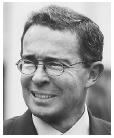COLOMBIA
Álvaro Uribe Velez
President

(pronounced "AL-vah-roh yoo-REE-bay VEH-lehz")
"We need the United States' help to preserve our democracy… we can no longer suffer terrorism."
The Republic of Colombia is located in the northwest corner of South America. Bordering Ecuador and Peru to the south, Brazil to the southwest, and Venezuela to the east, Colombia is the only South American country with a coastline on both the Pacific and Atlantic Oceans. Colombia connects the South American continent with the Central American isthmus through a narrow and densely forested border with Panama. In total, the country occupies 1,138,910 sq km (439,736 sq mi).
Colombia is the third most populated country in Latin America, with more than 40 million inhabitants (2002 estimate). Its population is 58% mestizo (mix of Spanish and indigenous), 20% white, 14% mulatto (black and indigenous), 4% black, and 4% mixed black-Amerindian, and 1% Amerindian. A majority of Colombians are nominally Roman Catholic (90%), but in recent years Protestants have made important gains in urban areas. Population growth stood at an annual rate of 1.64% in 2002. Improvements in health conditions have helped infant mortality decline to a rate of 23.2 deaths per 1,000 live births (2002). Life expectancy in 2002 was 70,85 overall (66.71 years for males and 74.83 years for females). The literacy rate has also increased in recent years, and now stands at 91.3%.
The economy has grown at an average of 2.5% over the past decade. Total gross domestic product (GDP) was estimated at US $255 billion in 2001. Exports were valued at an estimate US $12.3 billion in 2001, while imports were valued at an estimated US $12.7 billion. Colombia's leading trading partners include the United States, the Andean Community of Nations, and the European Union (EU). The nation's main exports are petroleum, fresh-cut flowers, bananas, rice, tobacco, corn, sugarcane, cocoa beans, oilseed, vegetables, forest products, and shrimp. Colombia imports industrial equipment, consumer goods, chemicals, and paper products. With a labor force of more than 18 million, the major source of employment is services (46%), followed by agriculture (30%), and industry (24%). The Colombian currency is the peso .
The illegal production and sale of cocaine has served as an important source of financial resources for the informal economy. Colombia is the world's largest processor of coca derivatives and the main supplier of cocaine to the United States and other international markets. More than 50,000 hectares (123,550 acres) of coca leaves are cultivated illegally, and the estimated profits from illegal drug production and export is more than US $5 billion annually.
ADDRESS
Palacio de Gobierno
Casa de Narino
Carrera 8A, No. 1–26
Santa Fe de Bogotá, Colombia
Comment about this article, ask questions, or add new information about this topic: